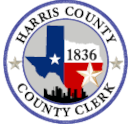Texas History
Glen Poole Jr., Harris County Clerk's Office Archives
March is Texas History Month, a time to fly the Texas flag high and celebrate our state's unique history. Recognizing the importance of preserving the history of Texas, on June 20th, 2003, the state legislature declared March 1-31st of every year as Texas History Month.
With our county in the seat of Houston, it is an area rich in history and independent spirit. The decisive battle of San Jacinto was fought and won in Harris County, gaining Texas its independence from Mexico and earning its status as an independent country. The Harris County Clerk's Office, in remembrance of both the events and the people that helped shape our beloved state, features documents from the Harris County Clerk's Archives.

Texas History
On March 27, 1836, over three hundred rebellious Texan prisoners, most of them captured a few days before while battling the Mexican army, were executed by Mexican forces. We see here in these documents what Mr. Joseph Loving left behind and how his assets are used to pay his debts back home in Harris County after the massacre.
The "Goliad Massacre" became a rallying cry for other Texans, who shouted "Remember the Alamo!" and "Remember Goliad!" at the decisive Battle of San Jacinto. James Henley, another soldier in the army of the Republic of Texas, leaves behind debts: one-third a league of land (one mile or 640 acres), and a beloved pet.
The Battle of the Alamo (February 23 – March 6, 1836) was a pivotal event in the Texas Revolution that took place in what is now modern day San Antonio. The documents shown detail proceedings following the death of Mr. Peter Mattern, a Harris County resident who was killed fighting in the Alamo.
Originally a native of Virginia, William Scott (1784-1837) was a planter, merchant, and stock raiser in his home state before coming to texas with Stephen F. Austin's "Old 300" colonists in 1824. He received a headright grant of land on the east bank of the San Jacinto River. Shown here is a document detailing information on the land that would eventually become part of Harris County in Baytown, Texas.
Luke Moore, another of the colonists that Stephen F. Austin brought with him to settle Texas located the claim for his league of land along Brays Bayou. Today MacGregor Park is located directly on this parcel of land, with the University of Houston adjacent. Moore died in 1837, and the land was sold by his estate in 1838.
Much has changed in the time since Texas became its own country in 1836. After independence, Texas sought annexation by the United States. However, the process took nearly 10 years. In 1845 Texas became the 28th state with a population of roughly 125,000. As of the 2020 census, the population of Harris County alone was 4,731,145, making it the most populous county in Texas and the third most populous county in the United States.
